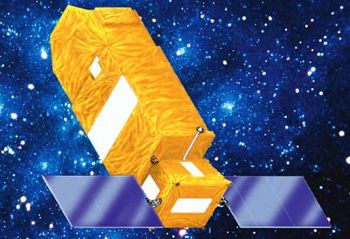
Home - Search - Browse - Alphabetic Index: 0- 1- 2- 3- 4- 5- 6- 7- 8- 9
A- B- C- D- E- F- G- H- I- J- K- L- M- N- O- P- Q- R- S- T- U- V- W- X- Y- Z
FUSE
 FUSE Credit: Manufacturer Image |
AKA: Far Ultraviolet Spectroscopic Explorer. Status: Operational 1999. First Launch: 1999-06-24. Last Launch: 1999-06-24. Number: 1 . Gross mass: 1,334 kg (2,940 lb).
The detectors cover the far ultraviolet band from the hydrogen ionization edge at 912 Angstroms to 1187 Angstroms, just short of the Lyman alpha line at 1215 Angstroms. These far UV spectra were to be used to measure the abundance of deuterium in the universe, as well as study helium absorption in the intergalactic medium, hot gas in the galactic halo, and cold gas in molecular clouds from molecular hydrogen lines.
NASA NSSDC Master Catalog Description
FUSE (the Far Ultraviolet Spectroscopic Explorer) represented the next generation, high-orbit, ultraviolet space observatory covering the wavelength range of 90.5-119.5 nm. The primary objective of FUSE was to use high-resolution spectroscopy at far ultraviolet wavelengths to study the origin and evolution of the lightest elements (hydrogen and deuterium) created shortly after the Big Bang, and the forces and processes involved in the evolution of galaxies, stars and planetary systems. FUSE is a part of NASA's Origins program. The spacecraft was launched as a joint US-Canada-France project. Only one previous mission, Copernicus, has given us this far-ultraviolet region of the electromagnetic spectrum. However, FUSE will provide sensitivity some ten thousand times greater than Copernicus.
The FUSE satellite consists of two primary sections, the spacecraft and the science instrument. The spacecraft contains all of the elements necessary for powering and pointing the satellite, including the Attitude Control System, the solar panels, and communications electronics and antennas. The observatory is approximately 7.6 m long with a baffle fully deployed.
The FUSE science instrument consists of four coaligned telescope mirrors (~39 cm x 35 cm clear aperture) based on a Rowland circle design. The light from the four optical channels is dispersed by four spherical, aberration-corrected holographic diffraction gratings, and recorded by two delay-line microchannel plate detectors. Two channels with SiC coatings cover the range 90.5-110 nm and two channels with LiF coatings cover the range 100-119.5 nm. Actuators on the mirror mountings will keep the focus to 90% encircled energy within 1.5". A Fine Error Sensor (FES) with a 21' square field will maintain the spacecraft pointing stability to 0.5 arcseconds.
The FUSE observatory was designed for an operational lifetime of three years, although it was hoped that it might remain opertional for as long as ten years.
NASA since recommended an additional two-year extension beyond the prime mission. FUSE Science Operations were on hold from Dec. 10, 2001, to approximately the end of January 2002, due to a problem with the pointing system.
The last operational reaction wheel on FUSE stopped on 12 July 2007. Attempts to restart any of the reaction wheels were unsuccessful. Although the telescope itself remained in excellent condition, the satellite was incapable thereafter of the fine pointing control required to acquire useful science data and the mission was terminated.
More at: FUSE.
Family: Astronomy, Medium earth orbit, Ultraviolet astronomy satellite. Country: USA. Launch Vehicles: Thor, Delta, Delta 2 7000, Delta 7320-10. Launch Sites: Cape Canaveral, Cape Canaveral LC17A. Agency: NASA Greenbelt. Bibliography: 2, 4, 6509, 12463.
1999 June 24 - . 15:44 GMT - . Launch Site: Cape Canaveral. Launch Complex: Cape Canaveral LC17A. Launch Pad: SLC17A. LV Family: Thor. Launch Vehicle: Delta 7320-10.
- FUSE - .
Nation: USA.
Agency: NASA Greenbelt.
Manufacturer: Germantown.
Class: Astronomy.
Type: X-ray astronomy satellite. Spacecraft Bus: MidStar.
Spacecraft: FUSE.
USAF Sat Cat: 25791 . COSPAR: 1999-035A. Apogee: 760 km (470 mi). Perigee: 745 km (462 mi). Inclination: 25.00 deg. Period: 99.90 min.
The Delta 3-m payload fairing was successfully jettisoned and the Far Ultraviolet Spectroscopic Explorer was placed in a 754 km x 769 km x 25.0 degree initial orbit. After separation the Delta second stage then a depletion burn and was left in a 182 x 915 km x 19.1 degree orbit from which it would quickly decay out of orbit. Checkout of FUSE in orbit was proceeding well as of July 1.
Back to top of page
Home - Search - Browse - Alphabetic Index: 0- 1- 2- 3- 4- 5- 6- 7- 8- 9
A- B- C- D- E- F- G- H- I- J- K- L- M- N- O- P- Q- R- S- T- U- V- W- X- Y- Z
© 1997-2019 Mark Wade - Contact
© / Conditions for Use